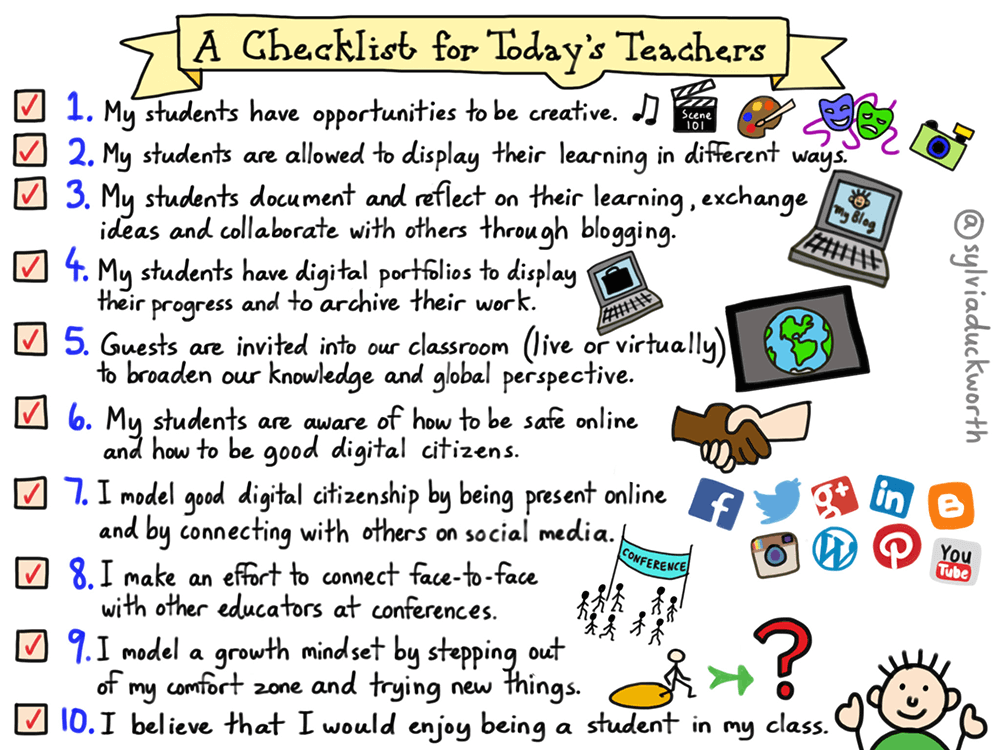
From Creativity to Assessment: A Checklist For Teachers Today
by TeachThought Staff
What are the kind of things a 21st-century teacher needs to know and be able to do?
What about 21st-century students? What education technology works, and what is a waste of time? What would a checklist for 21st-century teaching look like?
Does ‘21st-century teaching’ even make sense to use as a phrase anymore? If not, do we just say ‘teaching’? Does that fit our needs to innovate our collective profession to meet a modern circumstance?
These are among the questions today’s teachers have to face daily–in the classroom, mass media, professional development, and more. These conversations can get complex, opinionated, stuffed with rhetoric, and downright overwhelming at times. In response, Sylvia Duckworth has made consistent contributions to this conversation by creating colorful illustrations that communicate many of these ideas in easy-to-skim, easy-on-the-eyes, tempting to pin and share graphics.
The above graphic gets at the idea of modern teaching through a simple checklist–ten items, all positive in nature, and actionable by almost any teacher. We’ve added a bit to each ‘check’ with an extension or resource below.
A Checklist For 21st Century Teachers
1. My students have opportunities to be creative.
Consider: 25 Of The Best iPad Apps To Promote Creativity In Students
2. My students are allowed to display their learning in different ways.
Consider: Another way to think about this is to think of it as publishing their learning–even designing lessons by thinking ‘publishing backward’: What sorts of ideas and work and collaboration should be published, and how can I help students do so?
3. My students document and reflect on their learning, exchange ideas, and collaborate with others,
Consider: It doesn’t have to be blogging necessarily–using the QFT in Project-Based Learning presents countless opportunities to publish artifacts of authentic work.
4. My students have digital portfolios to display their progress and to curate their best (or most important) work.
Consider: 5 Reasons To Use Digital Portfolios In The Classroom
5. Guests are invited into our classroom (virtually) to broaden our knowledge and global perspective.
Consider: This is often reduced to the tools of invitation (e.g., Zoom) but it’s more crucial to consider the purpose of invitation (e.g., what is this connection about, and what tangible ways can this improve student understanding?)
6. My students are aware of how to be safe online and how to be good digital citizens.
Consider: Make sure students understand what digital citizenship (beyond being ‘polite’ online) actually is/means before admonishing them to demonstrate it.
7. I model good citizenship by being present online and by connecting with others on social media.
Consider: Create an easy way for any student to contact you at any time online. This doesn’t mean you have to answer instantly or be ‘open’ 24/7, but general accessibility is part of any kind of working ‘relationship.’
8. I make an effort to connect face-to-face with other educators at conferences.
Consider: Step out of your comfort zone. Walk up to someone you see standing alone and say hello. Ask a question. Follow-up on something someone else says in smaller sessions and workshops.
9. I model a growth mindset by stepping out of my comfort zone and trying new things.
Consider: 9 Statements That Reflect A Growth Mindset
10. I believe that I would enjoy being a student in my class.
Consider: If not, what should you change and how quickly can you do it?
A Checklist For 21st Century Teachers; From Creativity To Assessment, A Checklist For Today’s Teachers
